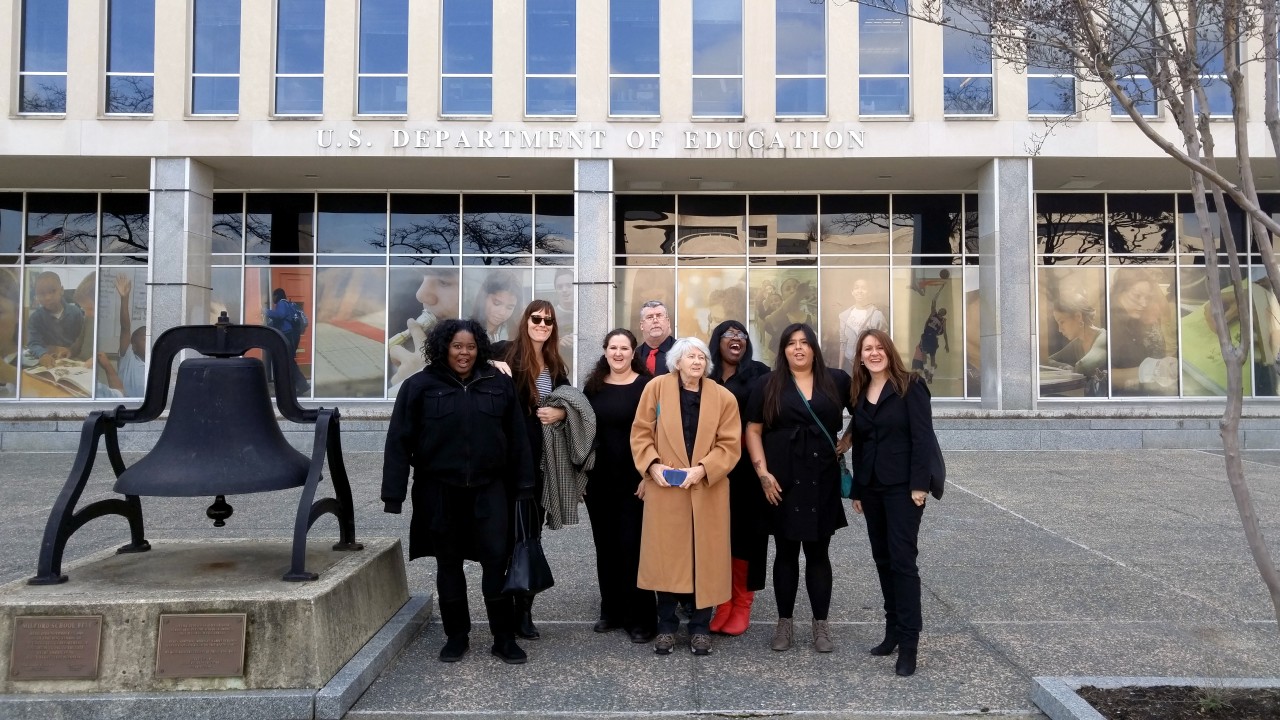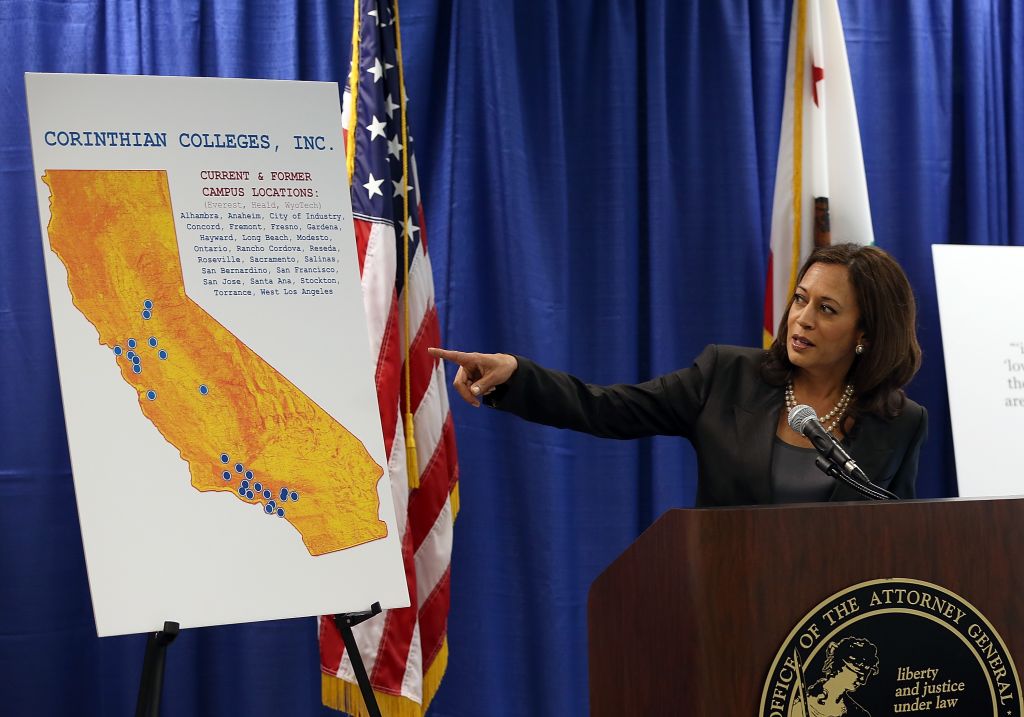
Debt strikers from left to right: Latonya Suggs, Debt Collective organizer Laura Hanna, Brittany Prock, Paul Hicks, Alicia Stevens, Pam Hunt, Makenzie Vasques and Debt Collective organizer Ann Larson.
Alicia Stevens was almost 60 when she decided to go back to school.
She had been working since she was 16, but thought that an accounting degree would help her get a better job, one that paid more and maybe even offered her some additional flexibility. A friend of hers was taking classes at Florida Metropolitan University, a subsidiary of the massive Corinthian Colleges chain, and in 2005, Stevens signed up, taking out government-backed student loans to cover the costs of her program.
— Alicia Stevens
In 2007, she completed her two-year program, but before she could begin looking for work, she was diagnosed with breast cancer. Through her cancer treatment, she stayed at the job she had, but lost it during the recession. With $22,000 in debt to pay down from her degree, she reached out to the career placement service that FMU had touted at her admission. She was told to look on Monster.com, but the only job interview she got was for a position she’d found in the local paper.
“The interview seemed to go well,” she recalls, up until the moment when the interviewer looked at her resume. “She said, ‘Your degree isn’t any good.'”
That was when Alicia Stevens found out that the school did not have proper accreditation. “To find out that I owed all this money and couldn’t use the degree really hurts,” she says. Since then, the entire Corinthian chain has folded and was sold off for parts, leaving her and other students even more stranded. “I live on $914 a month. They want about $350 a month if I were to pay my student loan,” she says. “I really feel ripped off. I did what I was supposed to do, I went to school, I expected the Department of Education to protect me and let me know if the school was going to defraud me.”
It’s one of the hidden truths of the $1.3 trillion bubble of student debt that older people actually carry a significant portion of it. Student debt held by those between 50 and 80 years old has more than doubled since 2003, whether that’s in borrowing through the federal Parent PLUS loan program to help their children pay for school or, like Stevens, going back to school themselves to improve their chances in an increasingly precarious job market. And yes, Social Security can be garnished to pay down student debt. For someone like Stevens, living on that payment, the fear of garnishment is a fear of destitution.

Students protest the rising costs of student loans for higher education on Hollywood Boulevard in 2012. (Photo by David McNew/Getty Images)
On February 17, in Washington, DC, Stevens joined thirteen members of the Debt Collective, an Occupy Wall Street spinoff, to tell her story before the Department of Education’s negotiated rulemaking committee, assembled to determine a process by which students like Stevens can see their loans forgiven. She’s 70 now, and last year she joined the collective after reading about fifteen Corinthian students who had gone on debt strike, demanding class-wide loan forgiveness for the students who, like her, were ripped off by the forprofit, higher education company.
The Debt Collective was developed by the group Strike Debt, a former Occupy working group. It’s sort of a “union for debtors,” an organization that allows debtors to find others who share their situation and plan collective actions. In the early days of Occupy, the idea of debt strikes was popular, but the Corinthian students were the first to pull one off. Strike Debt found them while researching buying debt from the secondary market, where defaulted loans are sold to debt collectors for pennies on the dollar. Strike Debt had been buying debt in order to abolish it in what they call the “Rolling Jubilee,” but also was looking for a way that debtors could take action on their own behalf.
The original 15 strikers have ballooned to over 200, but what they haven’t seen, say Debt Collective organizers Laura Hanna and Ann Larson, is real relief. The Obama Administration appointed Joseph Smith as a special master to guide the Corinthian debt relief process, and in December, Smith recommended forgiveness for the loans of 1,312 former students of Heald College, another Corinthian subsidiary.
The number sounds big, and Larson and Hanna note that they’ve even been congratulated for it, but it represents just one percent of the 125,000 former Corinthian students struggling with a substandard education, cancelled programs, and worthless degrees.
Ann Bowers was one of the original 15 strikers; she enrolled in an online program in business marketing in 2011, and was there when Corinthian melted down. After an investigation, the Department of Education shut off the spigot of federal loans that made up the vast majority of the school’s income and Corinthian folded. The DOE provided an emergency “bailout” and stepped in to oversee the process of selling off the parts of the chain, but Bowers was left with an incomplete degree, credits that wouldn’t transfer, and $40,000 in debt, all of it borrowed from the federal Direct Loan program.
Now she’s sitting on the negotiated rulemaking committee as a student representative but, she says, “I can’t be optimistic.” So far, the proposals include a statute of limitations for borrowers to file fraud claims but the process remains highly individualized. “They aren’t interested in class-wide discharges,” Hanna and Larson say. “The overall proposed rule would throw up barriers to relief, make it an individualized process that’s incredibly burdensome.” Another proposal would pit the students against the schools — and, presumably, the schools’ expensive lawyers.
A statute of limitations would mean that people like Alicia Stevens with loans more than a decade old couldn’t get any relief on their debt, even though the DOE has clear rules that students who have been defrauded are to get loans forgiven. Stevens points out that her school had been under investigation for years before anything was made public: “How many years did the feds keep sending money to a school they knew wasn’t doing what it was supposed to do?”

California Attorney General Kamala Harris announces the filing of a lawsuit against the for-profit Corinthian Colleges and its subsidiaries for alleged false advertising, securities fraud, intentional misrepresentations to students and the unlawful use of military insignias in advertisements. (Photo by Justin Sullivan/Getty Images)
It’s not just the Debt Collective that thinks the process has failed students. California Attorney General Kamala Harris, who has been investigating the California-based Corinthian subsidiaries, released a statement February 25 that criticized the DOE’s process, saying, “Fair and effective defense-to-repayment procedures (1) must look to state law as a basis to assert a defense; (2) must not be limited by any time period; (3) must provide procedures for automatic, global relief to students where it is clear that they are the victims of rampant school misconduct; and (4) must not permit the school to make the process burdensome and expensive.”
Mark Huelsman, a senior policy analyst focusing on higher education at the nonpartisan think tank Demos, is also critical of the Department of Education: “The problem that we’ve seen over the past year and a half is that the effort to ensure that Corinthian’s fall wasn’t a total catastrophe is not being met by the effort to make sure that the students who were defrauded — and we know now that they were defrauded — have a very easy, simple, expedited process for debt relief.” Forprofit colleges, he notes, make most of their money from the federal government either through student loans or GI Bill benefits, but face very little oversight. “The ability to participate in student aid programs or veterans benefit programs is an explicit stamp of approval by the Department of Education that this a worthwhile path to upward mobility.”
— Mark Huelsman, Demos
For now, the only option for students is to file individual defense-to-repayment claims; the Debt Collective created an app to expedite that process, and they say that more than 5000 students have used it to file claims, but that, too, is a drop in the 125,000-student bucket. Huelsman calls the DOE’s outreach to defrauded students “substandard,” and notes that the Massachusetts attorney general’s office has helped more students apply for relief than the federal government. While the government ensures that every dollar of debt relief goes to students who “deserve it,” he says, the DOE was happy to keep sending money to institutions that certainly did not.
There’s another way that the rules favor Corinthian and institutions like it but disadvantage the students, says Denise Eliason, another Debt Collective member. “A big company like that can file bankruptcy but we have no rights regarding that, we’re stuck with it.” She’s right: the 2005 bankruptcy reform law made even private student loans non-dischargeable in bankruptcy, completing a years-long process of chipping away at student borrowers’ legal rights.
Eliason is 55 now; like Stevens, she had been considering an accounting degree for a while and in 2011 found an online program at Everest College, another Corinthian subsidiary. When she first connected with the school, they were a little pushy, she says, particularly when they found out that her husband was a disabled military veteran. She had less than two terms to go to get her bachelor’s degree when, under the aegis of the DOE, Everest was sold. “I got an email one morning saying I needed to watch a video,” she explains. “It gave me an option to go into a different program or continue on with the accounting program or to withdraw and get a partial refund of my loans.” The refund, around $17,000, sounded nice, but she already had $60,000 in loans. “I was a number to them, just like everybody else,” she says.
She’d met Ann Bowers through the online program, and Bowers told her about the Debt Collective. She joined up, and enrolled in a different school. “Now I’m actually learning what I should’ve learned before,” she says. “I was a 4.0 at Everest, but I’m thinking I got the grades just because I showed up.”
“The Department of Education has to get out of being a bank, that’s not their job,” Alicia Stevens says.
And yet most of the solutions proposed by the DOE and the federal government are just the kind of tinkering done by other financial institutions. Proposals are floated to refinance student loans, lower interest rates, or to expand income-based repayment plans, but these plans don’t make a dent in the principal. Most officials have steered clear of calling for outright forgiveness. The Corinthian students are seen as a small group in extraordinary circumstances who must prove they were defrauded, but the rulemaking committee’s decisions, going forward, will affect everyone.

Everest College, one of the Corinthian College brands, in Milwaukee, Wisconsin in 2010. (Jeramey Jannene/Flickr cc. 2.0)
“I feel like they’re trying to make it look like they’re doing something for the students, especially by having me there,” Ann Bowers says. “But they’ve got forprofits at the table as well, and of course I’m not going to see eye to eye with the forprofits.” The negotiations she’s part of will not take effect for at least a year, and the special master process, she says, could also take years. Meanwhile, Mark Huelsman warns, “We could be on the verge of having students from multiple institutions in this situation. Corinthian is the biggest example of a forprofit going under, then being bailed out, in US history, but there are other institutions that are wobbling at the moment that are also quite big. Like the mortgage crisis, this is a systemic issue in which many people are going to have lost, while we try to figure out whether it’s efficient to try to do debt relief on a highly individualized level. The people who deserve relief are never going to get it that way.”
Several other schools are under investigation by the federal government or state governments, have been sued by multiple states, and have sky-high default rates on their student loans; nevertheless, they continue to receive federal student loan dollars. ITT Tech, for example, has faced repeated investigations and lawsuits, and the Federal Trade Commission announced an investigation into the struggling, yet ubiquitous, University of Phoenix last summer. The Defense Department has blocked the University of Phoenix from getting funds from its tuition assistance program for active-duty service members and from recruiting on military bases. There are over 500 schools on the Department of Education’s Heightened Cash Monitoring list, meaning they are under review for potential problems including accreditation issues or financial problems, and not all of them are forprofits.
In other words, there are a lot of people out there in the same situation as the Debt Collective members. Not all of them went to schools guilty of obvious malfeasance, either. “Most people are working through school and most people still have to take on debt and the debt amounts are growing, growing, growing every year,” Huelsman notes. For the working class and students of color, the path of upward mobility is now a weight dragging them down, and even a small amount of debt can be an impossible burden when the only jobs available pay minimum wage. The forprofits are the most obvious bad actors, but as Denise Eliason says, their fight is just the tip of a $1.3 trillion iceberg. But it is an important place to start, Eliason says, and “hopefully we can get that iceberg melted.”
Indeed, students from other colleges have already joined the debt strike. Even as advertisements for ITT Tech and the University of Phoenix still clog Eliason’s TV, students who have attended those schools are adding their voices to the call for reform. And while she still wonders what will happen with her debt, Eliason says of her work with the Debt Collective, “It’s given me my life back. I felt like I was all by myself but when you get together with a bunch of people in the same situation and know what you’re going through, it has really done a lot for me.”
Ann Bowers is impressed by how much their movement has grown in the year since she joined the strike, even if she doesn’t know what happens when the administrative forbearance she’s been given on her loans is up in April. “I asked at the table what’s going to happen when April rolls around and forbearance ends, I never really got an answer.” The next — and last — negotiated rulemaking session is March 18, and the Debt Collective hopes that their presence at the last session had some impact.
Rather than funneling federal money to schools like Corinthian, Bowers suggests, the federal government would be better off funding public higher education. “Public institutions are suffering while we dump money into the forprofits,” she says.
To Alicia Stevens, who stood in front of the rulemaking committee and declared “I am not a victim,” it’s a fight that might take the rest of her life. She called her loan servicer, she says, and was told that she had 25 years of income-based repayment before her loan could be forgiven. “I couldn’t help it, I just cracked up laughing,” she says. “I said ‘That’s true because in 25 years it’s either going to be forgiven because I’ve lived long enough to have it forgiven or I’ll be dead because I’m going to be 95.’ There was dead silence on the other end of the phone.”
The friend who’d first recommended a Corinthian school to her passed away from cancer two and a half years ago, struggling under her own debt burden. “She had to get cancer and die in order to get her loans forgiven,” Stevens says. “I don’t want to die in order to get my loans forgiven, that shouldn’t be a prerequisite.”
Update: As this story was going to press, a group of 35 Senators, including Elizabeth Warren (D-MA), Patty Murray (D-WA), Dick Durbin (D-IL) and presidential candidate Bernie Sanders (I-VT) sent a letter to the Obama administration calling for expedited debt relief for students who have been defrauded, in terms quite similar to those used by the activists in this piece. The full letter can be read here.
And on March 23, California Attorney General Kamala Harris won “a more than $1.1-billion judgment…against the now-defunct Corinthian Colleges, after a San Francisco judge ruled that the company’s advertising practices misled students and violated the law.” Read about it at The Los Angeles Times »




